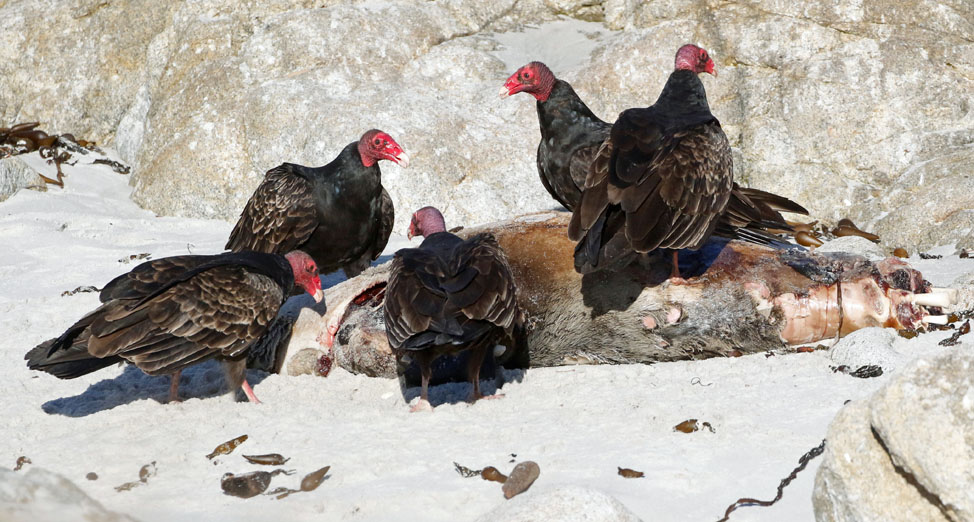
a web page by Don Roberson |
 |
||
NEW WORLD VULTURES Cathartidae |
||
|
||
Black Vulture (left) has adapted to most lowland habitats from the southern United States to Tierra del Fuego. It is commensal with humans in towns and cities. Greater Yellow-headed Vulture (above) is more specialized and restricted to lowland rain forest of South America. |
||
| Among the seven species are some spectacular and specialized large birds. One of these is the King Vulture — the two large birds in the roost shown below; one colorful adult and one young bird above and to the left of the adult (the smaller ones are the widespread Black Vulture). King Vultures are scarce across their wide range across the primary forests and savanna of the Neotropics. Adults are primarily white-plumaged with an incredible array of colors on their bare heads and necks; the particular adult appears to have a full crop (bare skin in center of breast). Young birds are all-black, including the bare head. It is rare enough to see a King Vulture gliding over the forest from afar, so that when I had this opportunity to photograph these at a roost in southern Brazil, I was so delighted that I crawled through the thick grass to get this shot, subjecting my ankles to an attack of chiggers that still itched incessantly for many month thereafter. | ||
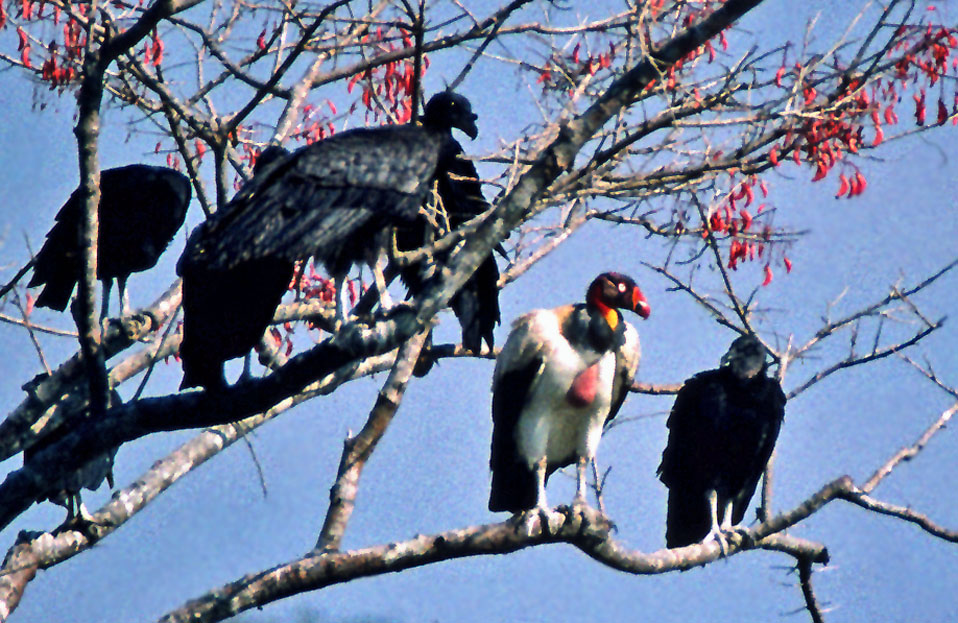 |
||
|
||
The California Condors described to science by British naturalist George Vancouver back in 1792 were foraging on dead whales on the shores of Monterey Bay. It is now quite wonderful to watch a wild condor foraging along the wild Big Sur coast! A dead Gray Whale that washed up in 2006 fed the entire local population for half-a-year (Roberson 2008, which summarizes the reintroduction efforts to that date). This adult condor (below) is scavenging a washed-up sea lion on the Little Sur River beach. |
||
 |
||
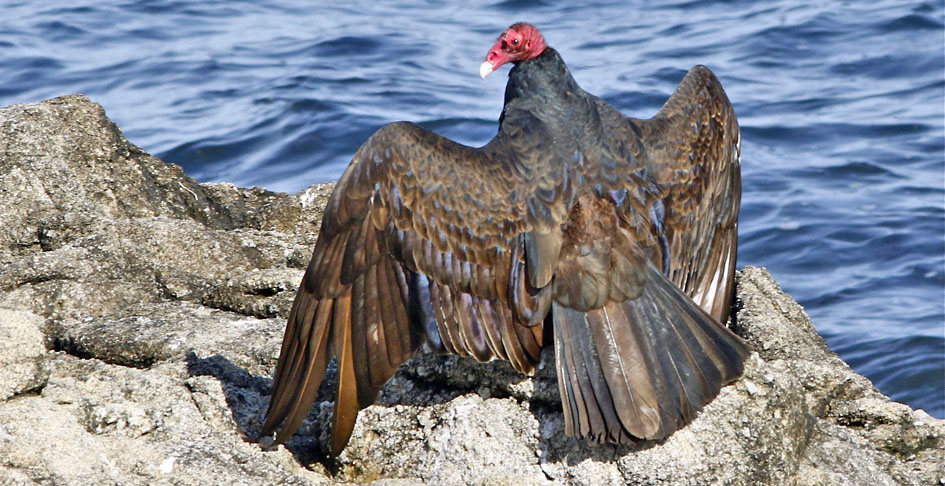 |
||
| The Turkey Vulture photo (above) illustrates one typical cathartid vulture behavior: wing-sunning. Many New World Vultures spend substantial time spreading their wings — often early in the morning — which both serves thermoregulatory functions and brings the plumage into good condition. Vultures tend to forage most of the day, riding thermal to thermal but searching for recently-dead meat over a wide range, but return to communal roosts at night. You may be able to see one of the features that separates New World Vultures from Old World Vultures in this above photo: cathartid vultures lack any internal separation in the nostrils, meaning that you can "see right through" the nostrils on the bill to the scenery behind. [The other obvious difference in morphology is the lack of a functional hind toe in cathartids; Houston 1994.] | ||
Of course, New World Vultures are well-known for their adaptations to eating carrion: these two Turkey Vultures (above) are scavenging a dead gull. New World Vultures are also fascinating for the specialization and co-dependency of species within this family. The huge condors — California Condor in North America and Andean Condor in western South America — plus the King Vulture of the Neotropics, could not exist without contemporaneous small vultures of the genus Cathartes. Only these small vultures have a highly-developed sense of smell — ranking them with kiwis and some petrels in this ability. As dramatically shown in the BBC's video series "Life of Birds with David Attenborough", a Turkey Vultures has a remarkable ability to locate recently-dead mammals using nothing but their sense of smell. This ability is shared by the Lesser Yellow-headed and Greater Yellow-headed vultures of the Neotropics. The big vultures (King Vulture and the condors), with great eye-sight but poor smell, rely primarily on the small vultures to find carrion. The big bruisers then "take-over" the carcass for their fill, but at the same time specialize on skin, tendons, and other tough meat less readily eaten by the small cousins. Black Vultures also lack a good sense of smell, but feed more on easily-found offal, such as dead fish on shorelines or at man-made dumps. My photo (below) shows three species of small vultures lined up on a fence (from left to right: a Lesser Yellow-headed Vulture, a Black Vulture, and two Turkey Vultures). This shot was taken in the Pantanal of Brazil where the resident Turkey Vultures have a conspicuous white patch on the nape, quite different from the highly-migratory red-naped North American birds. |
||
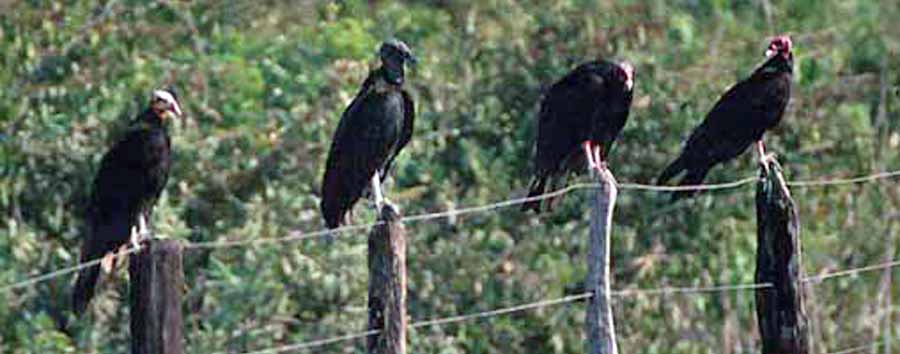 |
||
|
||
|
||
Photos: The Greater Yellow-headed Vulture Cathartes melambrotus was in flight over the Brazilian Pantanal on 21 July 2010. The Black Vulture Coragyps atratus was near Lima, Peru, on 26 Nov 2014. The roost of King Vulture Sarcoramphus papa and Black Vultures was taken in the Serra das Araras, Mato Grosso, Brazil, on 4 Aug 1999 — this particular roost contained ten King Vultures and dozens of Blacks. The California Condor Gymnogyps californianus was in flight along the Big Sur coast of California on 25 Feb 2010; the circling adult and immature were east of King City, Monterey Co., CA, on 20 Mar 2015, and the adult condor on Little Sur River beach was taken 18 Feb 2018. The wing-drying Turkey Vulture Cathartis aura was at Pebble Beach on 30 Mar 2018, and the two scavenging a gull were at Big Sur R. mouth on 17 Feb 2007. The Lesser Yellow-headed Vulture Cathartis burrovianus on a fence with Black and Turkey Vultures was in the Pantanal of Mato Grosso, Brazil, in Aug 1999. The Thanksgiving Dinner sequence with Turkey Vultures was at Pebble Beach, Monterey Co., California, on 17 Dec 2021. All photos © Don Roberson; all rights reserved. Bibliographic note: Photos: There is no "family book" per se but an excellent introduction to this family is in Houston (1994). Literature cited:
|
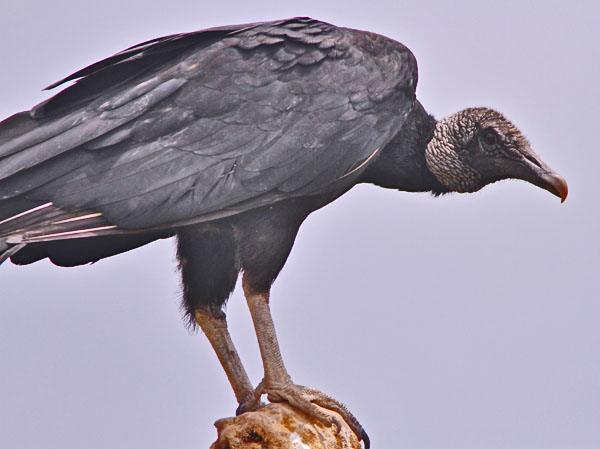 The New World Vultures, or "cathartid vultures," are the carrion-eating "buzzards" of the New World. They are similar in many ways to the 15 species of Old World Vultures (carrion-eating habits, bare heads, strong bills, incredible powers of flight) but the two groups have evolved separately from different ancestors. Indeed, the two sets of vultures are among the best examples of convergent evolution (Griffiths 1994, Houston 1994). In the 1990s there were suggestions that New World Vultures evolved from the stork lineage but newer molecular evidence did not support that theory. The Cathartidae is now the only family within the Order Cathartiformes (Johnson et al. 2016).
The New World Vultures, or "cathartid vultures," are the carrion-eating "buzzards" of the New World. They are similar in many ways to the 15 species of Old World Vultures (carrion-eating habits, bare heads, strong bills, incredible powers of flight) but the two groups have evolved separately from different ancestors. Indeed, the two sets of vultures are among the best examples of convergent evolution (Griffiths 1994, Houston 1994). In the 1990s there were suggestions that New World Vultures evolved from the stork lineage but newer molecular evidence did not support that theory. The Cathartidae is now the only family within the Order Cathartiformes (Johnson et al. 2016). 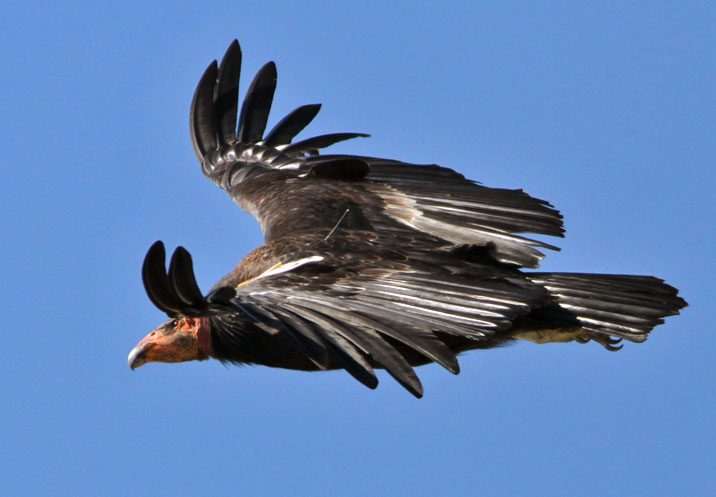 The two species of condor are the other headliners among cathartid vultures, and the créme de la créme is California Condor (right). I was fortunate enough to see wild condors from Mt. Pinos and several other southern California locales (an excellent resource for the history of California Condor is Wilbur 1978) but by 1982 only 21 remained in the world. The decision was made to capture them all before they went extinct. The last wild condor was netted in April 1987 for an intensive attempt at captive breeding (after research on breeding Andean Condors Vultur gryphus had occurred). Fortunately, this massive effort — the most expensive and complex effort to save a species ever undertaken — has been successful to date. The first captive-born condors were released back into the wild in 1992 near the Mt. Pinos area of southern California, and by 1998 the world population (including captive birds) was 145. Efforts to re-introduce the condor in its native range expanded to my home county — Monterey County — in Dec 1997 & Jan 1999, when a dozen young birds were released, and more each year thereafter. My photo (above) is one of those released condor, bearing a wing tags and radio transmitter.
The two species of condor are the other headliners among cathartid vultures, and the créme de la créme is California Condor (right). I was fortunate enough to see wild condors from Mt. Pinos and several other southern California locales (an excellent resource for the history of California Condor is Wilbur 1978) but by 1982 only 21 remained in the world. The decision was made to capture them all before they went extinct. The last wild condor was netted in April 1987 for an intensive attempt at captive breeding (after research on breeding Andean Condors Vultur gryphus had occurred). Fortunately, this massive effort — the most expensive and complex effort to save a species ever undertaken — has been successful to date. The first captive-born condors were released back into the wild in 1992 near the Mt. Pinos area of southern California, and by 1998 the world population (including captive birds) was 145. Efforts to re-introduce the condor in its native range expanded to my home county — Monterey County — in Dec 1997 & Jan 1999, when a dozen young birds were released, and more each year thereafter. My photo (above) is one of those released condor, bearing a wing tags and radio transmitter. 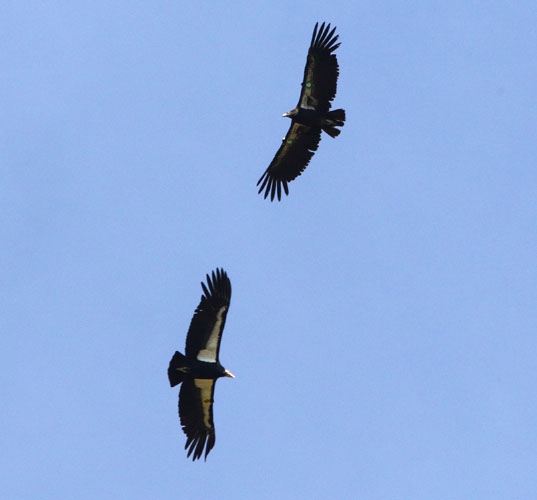 Some had to be recaptured, but others began ranging widely. The project expanded to Pinnacles National Park just east of Monterey County. The adult and young condor (photo left) were east of King City, and may be moving between populations (the adult is below the young condor in this photo).
Some had to be recaptured, but others began ranging widely. The project expanded to Pinnacles National Park just east of Monterey County. The adult and young condor (photo left) were east of King City, and may be moving between populations (the adult is below the young condor in this photo).